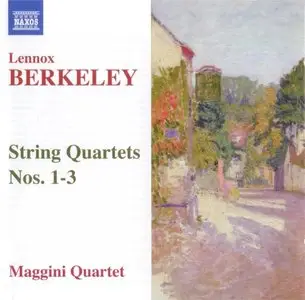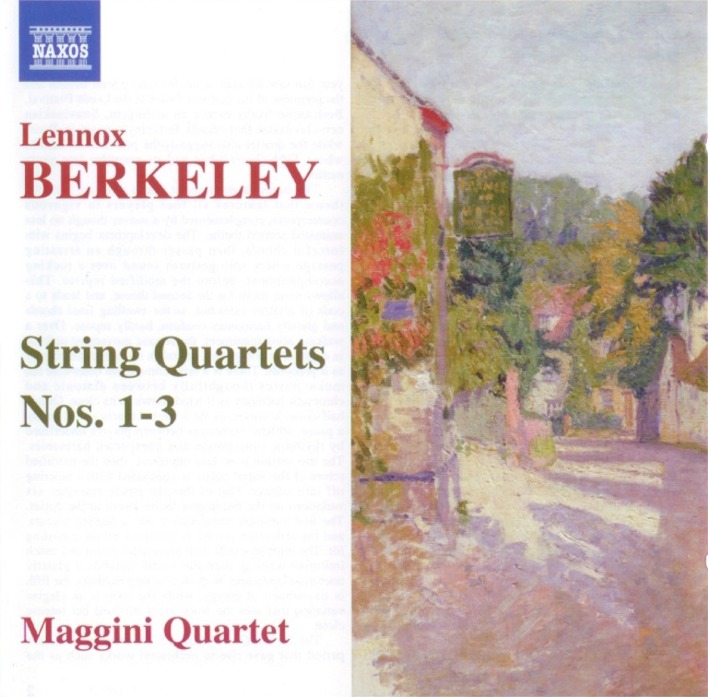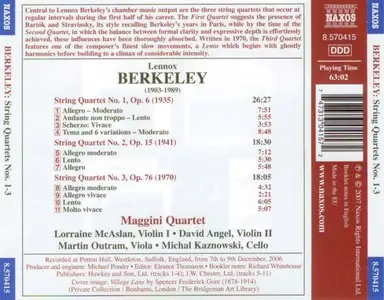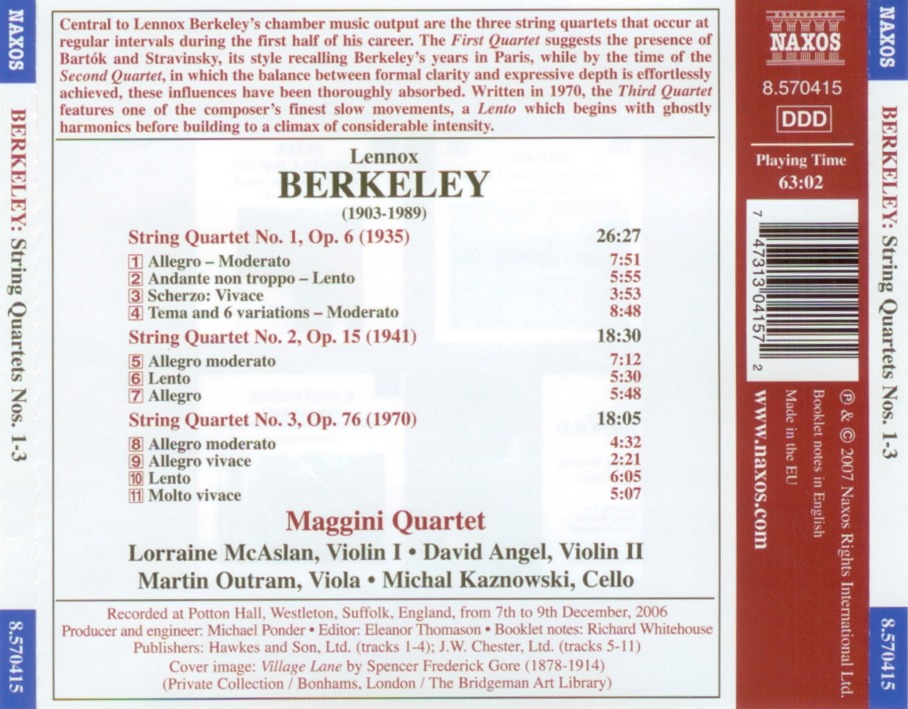Lennox Berkeley - String Quartets Nos.1-3 (2007)
EAC RIP | APE + CUE + LOG | COVER + BOOK | RAR FILES (3% recovery) | 277 Mb
Classical | Naxos 8.570415
EAC RIP | APE + CUE + LOG | COVER + BOOK | RAR FILES (3% recovery) | 277 Mb
Classical | Naxos 8.570415
Tracklist:
String Quartet No. 1, Op. 6
1. I. Allegro - Moderato 00:07:51
2. II. Andante non troppo - Lento 00:05:55
3. III. Scherzo: Vivace 00:03:53
4. IV. Theme and 6 variations: Moderato 00:08:48
String Quartet No. 2, Op. 15
5. I. Allegro moderato 00:07:12
6. II. Lento 00:05:30
7. III. Allegro 00:05:48
String Quartet No. 3, Op. 76
8. I. Allegro moderato 00:04:32
9. II. Allegro vivace 00:02:21
10. III. Lento 00:06:05
11. IV. Molto vivace 00:05:07
Lennox Berkeley was born near Oxford on 12 May 1903. He studied at Gresham's School, Holt (which his colleague and sometime collaborator Benjamin Britten was to attend a decade later), then read French and Philology at Merton College, Oxford. Graduating in 1926, he then moved to Paris where, on the advice of Ravel, he studied with Nadia Boulanger. In 1928 he became a Roman Catholic, which was to have a profound effect on his work. During the Second World War, he worked as programme planner for the BBC in London, and married Elizabeth Freda Bernstein in 1946 (his eldest son, Michael, has achieved recognition as a composer in his own right). From 1946-68 Berkeley was Professor of Composition at the Royal Academy of Music, with pupils including Richard Rodney Bennett, William Mathias and Nicholas Maw. He was made a CBE in 1957 and was knighted in 1974. Other honours include the Papal Knighthood of St Gregory (1973), a doctorate from Oxford University (1970) and membership of the American Academy of Arts and Letters (1980). During 1976-79 he was a Professor at Keele University, and from 1977 to 1983 was President of the Cheltenham Festival. His later years were marked by declining health, but he continued composing regularly until his 75th year. Berkeley died in London on 26 December 1989.
Although his early years were marked by uncertainty over stylistic direction, Berkeley amassed a catalogue of over a hundred works and contributed to almost every genre. His major works included four operas, four symphonies and several concertos, while his choral music [a selection is on Naxos 8.557277] ranks among the most significant from British composers of his generation. His chamber output includes pieces written for a wide variety of ensembles and combinations. Central to this are the three string quartets that occur at regular intervals during the first half of his career.
The First Quartet, Op. 6, was written in 1935, the year that saw the start of his friendship with Britten and the première of his oratorio Jonah at the Leeds Festival. Both these works evince an astringent, Stravinskian neo-classicism that recalls Berkeley's years in Paris, while the quartet also suggests the presence of Bartók, whose Fifth Quartet had had its première two years earlier.
The opening movement starts with an incisive theme that features all four players in vigorous counterpoint, complemented by a suaver though no less animated second theme. The development begins with forceful chords, then passes through an arresting passage where solo gestures sound over a rocking accompaniment, before the modified reprise. This allows more room for the second theme, and leads to a coda of relative calm but, as the swelling final chords and ghostly harmonics confirm, hardly repose. Over a walking accompaniment, the second movement unfolds in expressive polyphony, but takes on greater ambiguity as it proceeds. There is a brief climax, but otherwise the music moves thoughtfully between diatonic and chromatic harmony as it winds down to its close. Only a half-close, however, as the Scherzo launches with barely a pause; athletic exchanges between players underlined by rhythmic syncopation and unexpected harmonies. The trio section is no less impulsive, then the modified return of the initial music is concluded with a tapering off into silence. Out of this the finale emerges: six variations on the ruminative theme heard at the outset. The first variation transforms it into a driving toccata, and the reflective second is informed by an appealing lilt. The third proceeds with purposeful intent and much imitative writing, then the fourth inhabits a ghostly nocturnal landscape. With its coursing rhythms, the fifth is an outburst of energy, while the sixth is an elegiac variation that sees the work to its subdued but intense close.
The Second Quartet, Op. 15, followed in 1941, in a period that gave rise to orchestral works such as the First Symphony, Serenade and Divertimento, and vocal works such as Four Poems of St Teresa of Avila and a setting of the Stabat Mater. The influences evident in its predecessor have now been thoroughly absorbed, while the balance between formal clarity and expressive depth has been effortlessly achieved.
The first movement opens passively but assumes greater dynamism with its first main theme. The second theme is lighter and more quizzical in intent, without undermining momentum as the exposition reaches an impassioned climax. The development sets off with similar resolve, but initially vague references to the second theme gradually extend its emotional range. There is a shortened reprise, after which the movement winds down to a questioning close. The Lento is one of Berkeley's deepest slow movements, its initial theme yielding a number of motifs that are resourcefully discussed over its course. The theme itself is reassembled on the way to a poignant climax, after which the movement closes with its various motifs gently mused upon by the players. Opening with brusquely rhythmic gestures interspersed with expectant solo phrases, the finale settles upon an uneasy theme that finds productive contrast with the more inward episode that intervenes. The main theme returns with renewed force, driving the music to a heightened reappearance of those initial rhythmic gestures, followed by a coda that funnels the accumulated energy into a decisive final cadence.
The Third Quartet, Op. 76, did not appear until 1970, at the end of a decade that saw his final opera Castaway, the Third Symphony and the Magnificat. The period is also notable for Berkeley's recourse to elements of the serial technique that he had previously eschewed, but his approach is anything but dogmatic and, indeed, accords well with the stylistic ambit mined over the previous quarter-century.
The opening movement begins with a forceful theme in wide-ranging harmonies, complemented by a more relaxed theme that evinces greater passion as it unfolds. The development pointedly integrates these themes, bringing about a free reprise (almost a continuation of the development) before the movement ends with a haunting transformation of the second theme. The scherzo unfolds in driving counterpoint that moves through a number of distinctive gestures without settling on a theme as such. Nor is there a contrasting trio section; rather the movement reiterates its salient motifs through to the teasing close. Beginning with ghostly harmonics, the Lento is the emotional heart of the work: its initial introspection gradually builds to a climax of no mean intensity, followed by a plaintive discourse whose sureness of motion ensures a sense of purpose as the movement returns to the inwardness with which it began. The finale seems intent on dispelling any resulting uncertainty with its engaging initial theme, one that finds ready contrast with a more passive idea. The development at first elides between these moods with ease, but the emergence of a ghostly recollection of the slow movement sees an emphatic change of course. At length the main theme returns and the movement heads into its final stage with an accumulating energy that brings the decisive if peremptory close.
Richard Whitehouse
Exact Audio Copy V0.99 prebeta 4 from 23. January 2008
EAC extraction logfile from 5. April 2011, 16:23
Unknown Artist / Unknown Title
Used drive : ATAPI DVD A DH16A1L Adapter: 1 ID: 0
Read mode : Secure
Utilize accurate stream : Yes
Defeat audio cache : Yes
Make use of C2 pointers : No
Read offset correction : 6
Overread into Lead-In and Lead-Out : No
Fill up missing offset samples with silence : Yes
Delete leading and trailing silent blocks : No
Null samples used in CRC calculations : Yes
Used interface : Native Win32 interface for Win NT & 2000
Used output format : Internal WAV Routines
Sample format : 44.100 Hz; 16 Bit; Stereo
TOC of the extracted CD
Track | Start | Length | Start sector | End sector
––––––––––––––––––––––––––––-
1 | 0:01.00 | 7:51.43 | 75 | 35442
2 | 7:52.43 | 5:51.30 | 35443 | 61797
3 | 13:43.73 | 3:57.17 | 61798 | 79589
4 | 17:41.15 | 8:48.28 | 79590 | 119217
5 | 26:29.43 | 7:10.73 | 119218 | 151540
6 | 33:40.41 | 5:30.03 | 151541 | 176293
7 | 39:10.44 | 5:47.46 | 176294 | 202364
8 | 44:58.15 | 4:32.13 | 202365 | 222777
9 | 49:30.28 | 2:21.02 | 222778 | 233354
10 | 51:51.30 | 6:05.26 | 233355 | 260755
11 | 57:56.56 | 5:03.08 | 260756 | 283488
Range status and errors
Selected range
Filename C:\avaxhome\Baerkeley - Strings Quartets.wav
Peak level 100.0 %
Range quality 100.0 %
Copy CRC 9752C353
Copy OK
No errors occurred
AccurateRip summary
Track 1 not present in database
Track 2 not present in database
Track 3 not present in database
Track 4 not present in database
Track 5 not present in database
Track 6 not present in database
Track 7 not present in database
Track 8 not present in database
Track 9 not present in database
Track 10 not present in database
Track 11 not present in database
None of the tracks are present in the AccurateRip database
End of status report
password: basa005











